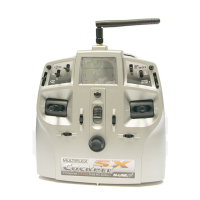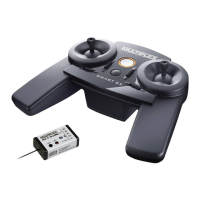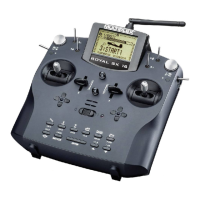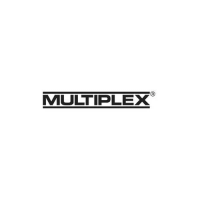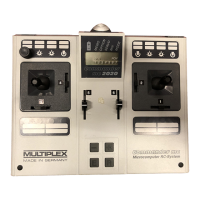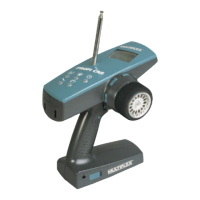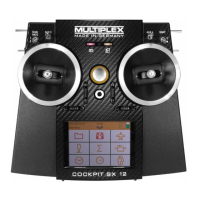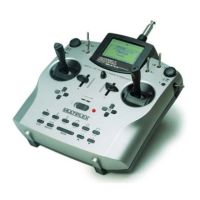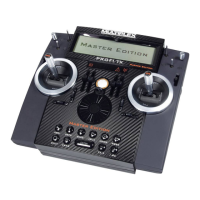18
To switch on:
Activate the transmitter by briey pressing the on/off button. If
the transmitter has not yet been used, it automatically starts in
the basic settings menu.
First of all, you can enter your name and desired language. You
can also specify which joystick will be used for the throttle/
spoilers later on.
After conrming by pressing the arrow button at the bottom on
the right, you are directed to the model assistant, as no models
have yet been saved on the SD card. A new model will now be
created with the help of the assistant.
The easiest way to create a new model is by using the
“Assistant”.
1. Start the assistant
Under model type, select the one which is best suited to your
model. Specify a name and le path for your new model and
conrm using the arrow key on the keyboard in the display.
2. Model types
The model types are broken down as follows:
a. Easy
Template for a simple glow-powered model aircraft (e.g.
Easystar) without ight phases.
· Aileron with mixable inputs for landing aps (spoilers), aps
(warping), elevator (snap ap)
· Combi switch (linkage aileron –> elevator/elevator –> aileron)
· Elevator/alternatively
V-tail with mixable inputs to avoid unwanted side effects/
compensation of aps (warping), spoilers (landing damper
function) and throttle.
· Channels 1-5 have already been permanently assigned in
order to ensure simple programmability.
b. Acro
The Acro template is the template for the classic aerobatic
planes and trainers (fun-cub, Funman, Extra....) In addition
to the functions listed under Easy, it is also possible to use
three ight phases. The servos can be freely assigned. On the
mixers (aileron and elevator), the ap mixer input has been
consciously deactivated.
c. Segler
The glider template also provides all the necessary functions
for gliders as well as those provided by the Easy and Acro:
· Three ight phases
· Two- or four-ap wing
(= two ailerons + two aps/camber-changing aps) with
mixable inputs for landing aps (spoilers) e.g. the buttery
function, aps (warping), elevator (snap ap), offset for offset
linkage of the elevator and V-tail.
· The servos can be freely assigned.
d. Delta
· Three ight phases
· Delta mixer for classic jets/deltas/ying wings
· Unrestricted servo assignment
e. Helikopter
· Four ight phases
· 90 degree ybarless (unmixed)
· 120 degree mixed
· Trims which can be switched off for gyros
· Nine point throttle/nine point pitch curve
· Unrestricted servo assignment
f. Multicopter
· Four ight phases
· Four multicopter main window functions
· Nine point throttle/nine point pitch curve
· Unrestricted servo assignment from the remaining
transmitter controls/switches
3. Delta / V-tail models
We have come up with something special to save you a lot of
time and effort adjusting settings.
Setting the direction of rotation of the servos on delta and
V-tail models is child’s play. To do this, all you have to do is
test through all eight possible combinations for type/variant,
until the elevator and aileron function is working as desired.
6. Switching on for the rst time
7. Creating a model
